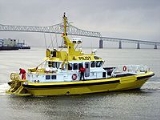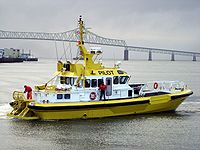
Maritime pilot
Encyclopedia

Ship
Since the end of the age of sail a ship has been any large buoyant marine vessel. Ships are generally distinguished from boats based on size and cargo or passenger capacity. Ships are used on lakes, seas, and rivers for a variety of activities, such as the transport of people or goods, fishing,...
s through dangerous or congested waters, such as harbours or river mouths. With the exception of the Panama Canal, the pilot is only an advisor, as the captain
Captain (nautical)
A sea captain is a licensed mariner in ultimate command of the vessel. The captain is responsible for its safe and efficient operation, including cargo operations, navigation, crew management and ensuring that the vessel complies with local and international laws, as well as company and flag...
remains in legal, overriding command of the vessel.
Pilotage is one of the oldest, least-known professions, yet it is one of the most important in maritime safety. The economic and environmental risk from today's large cargo ship
Cargo ship
A cargo ship or freighter is any sort of ship or vessel that carries cargo, goods, and materials from one port to another. Thousands of cargo carriers ply the world's seas and oceans each year; they handle the bulk of international trade...
s makes the role of the pilot essential.
History
The work functions of the pilot go back to Ancient GreeceAncient Greece
Ancient Greece is a civilization belonging to a period of Greek history that lasted from the Archaic period of the 8th to 6th centuries BC to the end of antiquity. Immediately following this period was the beginning of the Early Middle Ages and the Byzantine era. Included in Ancient Greece is the...
and Roman
Ancient Rome
Ancient Rome was a thriving civilization that grew on the Italian Peninsula as early as the 8th century BC. Located along the Mediterranean Sea and centered on the city of Rome, it expanded to one of the largest empires in the ancient world....
times, when locally experienced harbour captains, mainly local fishermen, were employed by incoming ships' captains to bring their trading vessels into port safely. Eventually, in light of the need to regulate the act of pilotage and to ensure pilots had adequate insurance, the harbours themselves licensed pilots.
Although licensed by the harbour to operate within their jurisdiction, pilots were generally self-employed, meaning that they had to have quick transport to get from the port to the incoming ships. As pilots were often still dual-employed, they used their own fishing boats to reach the incoming vessels. But fishing boats were heavy working boats, and filled with fishing equipment, hence a new type of boat was required.
Early boats were developed from single-masted cutters and twin-masted yawl
Yawl
A yawl is a two-masted sailing craft similar to a sloop or cutter but with an additional mast located well aft of the main mast, often right on the transom, specifically aft of the rudder post. A yawl (from Dutch Jol) is a two-masted sailing craft similar to a sloop or cutter but with an...
s, and later into the specialist pilot cutter. These were effectively light-weight and over-powered single masted boats with large steeply angled keels, making them deep draft
Draft (hull)
The draft of a ship's hull is the vertical distance between the waterline and the bottom of the hull , with the thickness of the hull included; in the case of not being included the draft outline would be obtained...
under power and shallow draft in lighter sail.
Duties involved

Million
One million or one thousand thousand, is the natural number following 999,999 and preceding 1,000,001. The word is derived from the early Italian millione , from mille, "thousand", plus the augmentative suffix -one.In scientific notation, it is written as or just 106...
s of dollar
Dollar
The dollar is the name of the official currency of many countries, including Australia, Belize, Canada, Ecuador, El Salvador, Hong Kong, New Zealand, Singapore, Taiwan, and the United States.-Etymology:...
s in damage. For this reason, many years of experience in an operating area are required to qualify as a pilot.
By far the most challenging part of any ship's voyage is the passage through the narrow waterways that lead to port
Port
A port is a location on a coast or shore containing one or more harbors where ships can dock and transfer people or cargo to or from land....
and the final dock
Dock (maritime)
A dock is a human-made structure or group of structures involved in the handling of boats or ships, usually on or close to a shore.However, the exact meaning varies among different variants of the English language...
ing of the ship. The pilot brings to the ship expertise in handling large vessels in confined waterways and expert local knowledge of the port. In addition to bringing local maritime expertise on board, the pilot also relieves the captain
Captain (nautical)
A sea captain is a licensed mariner in ultimate command of the vessel. The captain is responsible for its safe and efficient operation, including cargo operations, navigation, crew management and ensuring that the vessel complies with local and international laws, as well as company and flag...
from the economic pressures that can compromise safety. Instead of being part of the ship's crew, pilots are employed locally and therefore act on behalf of the public rather than of the shipowners. However, masters of ships that call at only a few ports, such as a ferry
Ferry
A ferry is a form of transportation, usually a boat, but sometimes a ship, used to carry primarily passengers, and sometimes vehicles and cargo as well, across a body of water. Most ferries operate on regular, frequent, return services...
, are issued a 'pilot exemption certificate'. Ships with an exempt ship master do not need to carry a pilot.

Pilot boat
A Pilot Boat is a type of boat used to transport pilots between land and the inbound or outbound ships that they are piloting.-History:The origins of the word pilot probably disseminates from the Latin word pilota, a variation of pedota, the plural of pēdón which translates as oar...
and climbs a pilot ladder
Pilot ladder
A Pilot ladder is a highly specialised form of rope ladder, typically used on board cargo vessels for the purposes of embarking and disembarking pilots...
sometimes up 40 feet (~12 metres) to the deck
Deck (ship)
A deck is a permanent covering over a compartment or a hull of a ship. On a boat or ship, the primary deck is the horizontal structure which forms the 'roof' for the hull, which both strengthens the hull and serves as the primary working surface...
of the largest container
Container ship
Container ships are cargo ships that carry all of their load in truck-size intermodal containers, in a technique called containerization. They form a common means of commercial intermodal freight transport.-History:...
and tanker
Tank ship
A tanker is a ship designed to transport liquids in bulk. Major types of tankship include the oil tanker, the chemical tanker, and the liquefied natural gas carrier.-Background:...
ships. With outgoing vessels, a pilot boat returns the pilot to land after the ship has successfully negotiated coastal waters.
Pilots specifically use pilotage
Pilotage
Pilotage is the use of fixed visual references on the ground or sea by means of sight or radar to guide oneself to a destination, sometimes with the help of a map or nautical chart. People use pilotage for activities such as guiding vessels and aircraft, hiking and Scuba diving...
techniques relying on nearby visual reference points and local knowledge of tide
Tide
Tides are the rise and fall of sea levels caused by the combined effects of the gravitational forces exerted by the moon and the sun and the rotation of the Earth....
s, swells, currents
Ocean current
An ocean current is a continuous, directed movement of ocean water generated by the forces acting upon this mean flow, such as breaking waves, wind, Coriolis effect, cabbeling, temperature and salinity differences and tides caused by the gravitational pull of the Moon and the Sun...
, depths and shoal
Shoal
Shoal, shoals or shoaling may mean:* Shoal, a sandbank or reef creating shallow water, especially where it forms a hazard to shipping* Shoal draught , of a boat with shallow draught which can pass over some shoals: see Draft...
s that might not be readily identifiable on nautical chart
Nautical chart
A nautical chart is a graphic representation of a maritime area and adjacent coastal regions. Depending on the scale of the chart, it may show depths of water and heights of land , natural features of the seabed, details of the coastline, navigational hazards, locations of natural and man-made aids...
s without first hand experience in the waters in question.
Beyond the experience and training of regular ship's captains, pilots also receive special, ongoing training to stay on top of their profession. Pilots are required by law in most major sea ports of the world for large ships.
Remuneration
The Florida Alliance of Maritime Organizations reported that Florida pilots salaries range from US$100,000 to US$400,000 annually. This was similar to other US states with large ports. Columbia River barColumbia Bar
The Columbia Bar is a system of bars and shoals at the mouth of the Columbia River spanning the US states of Oregon and Washington. The bar is about wide and long....
pilots earn about US$180,000 per year. A 2008 review of pilot compensation in the United States showed that pay ranged from about US$250,000 to over US$500,000 per year.
Compensation varies in other nations. In New Zealand, according to the government career service, pilots earn NZ$90,000-120,000.
In popular culture

- The novel ShōgunShogun (novel)Shōgun is a 1975 novel by James Clavell. It is the first novel of the author's Asian Saga. A major bestseller, by 1990 the book had sold 15 million copies worldwide...
by James ClavellJames ClavellJames Clavell, born Charles Edmund DuMaresq Clavell was an Australian-born, British novelist, screenwriter, director and World War II veteran and prisoner of war...
features John Blackthorne, an English pilot serving on the Dutch warship Erasmus, which is shipwrecked on the coast of Japan. - In the Gilbert and SullivanGilbert and SullivanGilbert and Sullivan refers to the Victorian-era theatrical partnership of the librettist W. S. Gilbert and the composer Arthur Sullivan . The two men collaborated on fourteen comic operas between 1871 and 1896, of which H.M.S...
comic opera The Pirates of PenzanceThe Pirates of PenzanceThe Pirates of Penzance; or, The Slave of Duty is a comic opera in two acts, with music by Arthur Sullivan and libretto by W. S. Gilbert. The opera's official premiere was at the Fifth Avenue Theatre in New York City on 31 December 1879, where the show was well received by both audiences...
Frederic's father directs his nursemaid Ruth to apprentice him to be a pilot, but instead she mishears and indentures him to be a piratePiracyPiracy is an act of robbery or criminal violence at sea. The term can include acts committed on land, in the air, or in other major bodies of water or on a shore. It does not normally include crimes committed against persons traveling on the same vessel as the perpetrator...
till his 21st birthday. - Dropping the PilotDropping the PilotDropping the Pilot is a political cartoon by Sir John Tenniel, first published in the British magazine Punch, March 1890. It depicts Chancellor Otto von Bismarck, as a maritime pilot, stepping off a ship , watched by the German Emperor Wilhelm II...
, famous cartoon by Sir John Tenniel

